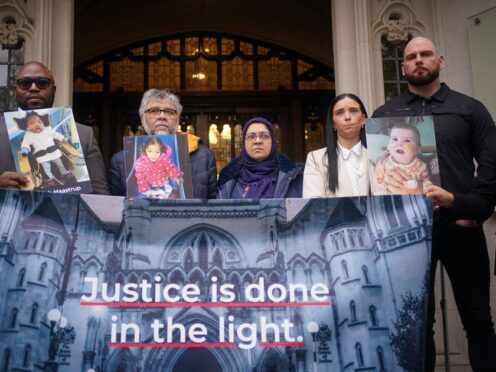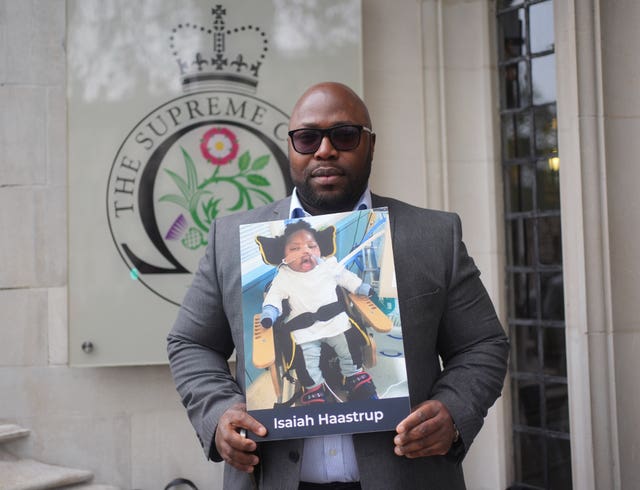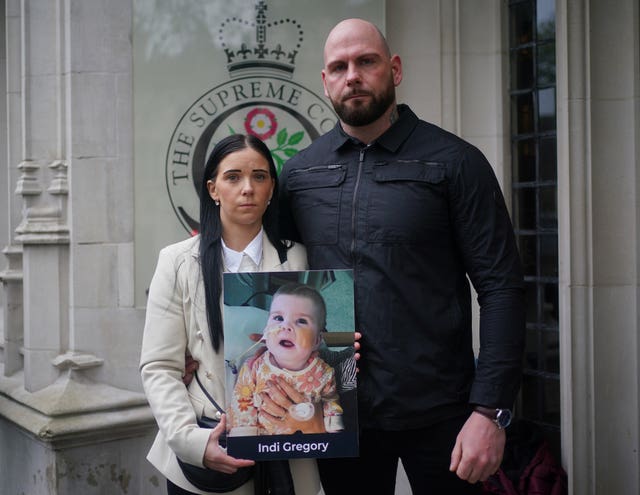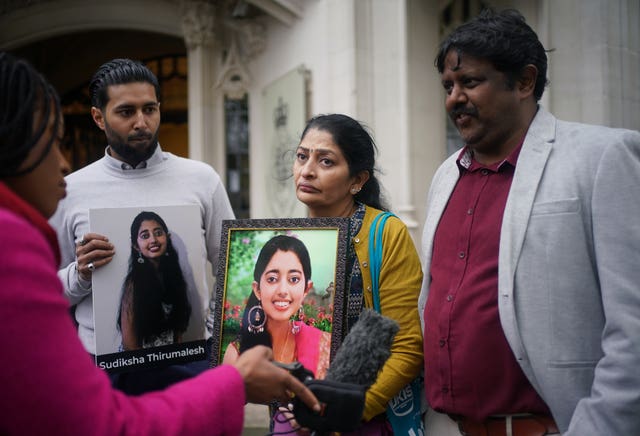
Parents who claim they were “gagged” in legal proceedings about their dying children have gathered at the Supreme Court as justices consider allowing the naming of doctors involved in two end-of-life cases.
Isaiah Haastrup, aged 12 months, and six-year-old Zainab Abbasi were at the centre of life-support treatment disputes at the High Court in London prior to their deaths in 2018 and 2019 respectively.
During the proceedings, court orders barring doctors involved in the children’s care from being publicly named indefinitely were put in place.
Last year, Zainab’s parents and Isaiah’s father won a Court of Appeal fight to have the clinicians named but the two NHS trusts involved, in Newcastle and London, are bringing a challenge to the UK’s highest court.

Ahead of Monday’s hearing, Isaiah’s father Lanre Haastrup told the PA news agency: “I want to tell my story, my story is not complete when the characters are not named.”
Mr Haastrup said he could understand “at that time” why the reporting restriction was made but said it was now “academic”.
“There’s no point of having it in place any more,” he said, adding that his son was a “fighter”.
Aliya Abbasi, Zainab’s mother, described her daughter as “the greatest blessing”, telling PA: “Her smile lit up the room even when she was poorly.”
Dr Abbasi continued: “We’ve lost our daughter, we’ve lost everything, but we just feel that there are so many other Zainabs out there, there’s so many other families, and we just have to speak up for the truth.”
Several families, including the parents of Indi Gregory and the mother of Archie Battersbee who were involved in high-profile legal battles over their treatment prior to their deaths, attended the Supreme Court on Monday.

Indi’s father Dean Gregory told PA: “We just want justice for the families who are going through what we’ve been through and to be able to tell the story because the professional doctors have nothing to hide.”
He added: “We don’t want anyone going through what we’ve been through…It felt like as parents we had no rights, Indi had her rights taken away.”
The family of 19-year-old Sudiksha Thirumalesh, who had a rare mitochondrial disorder, also attended the start of the two-day hearing in central London.
She and her family could not be named until after her death last September, with the NHS trust and doctors identified later.
Her brother Varshan Thirumalesh told PA: “Emotionally it felt like we were being jailed. We are here to tell her story to the whole world. She has been gagged for a very long time.
“It shouldn’t happen to any other family after this.”

In a ruling last year, three judges at the Court of Appeal said the rights of the parents to “tell their story” outweighed the privacy rights of the clinicians and staff that remained “long after” the court orders were made.
Former lord chief justice Lord Burnett said: “The wider systemic concerns which affect the operation of the NHS laid before the court by representative bodies cannot justify the creation of a practice, not anchored to the specific circumstances of the case, of granting indefinite anonymity to those involved in end-of-life proceedings.”
But Gavin Millar KC, for Newcastle Upon Tyne Hospitals NHS Foundation Trust and King’s College Hospital NHS Foundation Trust, said the Court of Appeal’s decision “contains a number of clear and obvious missteps”.
In written submissions for Monday’s hearing, the barrister said the judge who originally upheld the court orders “had well in mind the fact that the identities of the clinicians would be publicised in conjunction with allegations being made against them by the parents, connected to the emotive issues in the end-of-life proceedings”.
The five Supreme Court justices hearing the case will receive evidence from a number of medical bodies, including the British Medical Association and the Royal College of Nursing.
Alex Ruck Keene KC, for the Faculty of Intensive Care Medicine (FCIM), said in written submissions that some healthcare professionals in high-profile cases have faced “intimidating behaviour and death threats” as well as being “named and shamed” on social media.
The barrister continued: “The FICM submits that the impact of the nature and tone of such social media postings, if directed not at a named organisation but at a named person, on the individual identified clinician would be incredibly distressing.
“If the restrictions on naming the treating healthcare professionals are to be lifted either before or after the conclusion of proceedings, or indeed the death of the patient, this would allow the possibility of personal abuse being communicated directly to the named clinician by individuals.”
However, in written submissions for the parents, barrister Bruno Quintavalle said: “Confidentiality is owed by the clinician to the patient not by the patient to the clinician. A patient may lawfully make public comment, either positive or negative, about the treatment he has received from a named clinician.
“Clinicians, like other professionals, are well aware of this and so cannot have any expectation that their professional relationship will be kept permanently private.”
The hearing before Lords Reed, Hodge, Briggs, Sales and Stephens is due to conclude on Tuesday with a decision expected in writing at a later date.

Enjoy the convenience of having The Sunday Post delivered as a digital ePaper straight to your smartphone, tablet or computer.
Subscribe for only £5.49 a month and enjoy all the benefits of the printed paper as a digital replica.
Subscribe